| Please access the following URL if you want to secure using SSL. All pages in the site will be secure pages. |
https://secure02.blue.shared-server.net/www.fish-food.co.jp/message english 12.2023.html |
Welcome to FISH FOOD TIMES
Dec. 2023 issue No.240

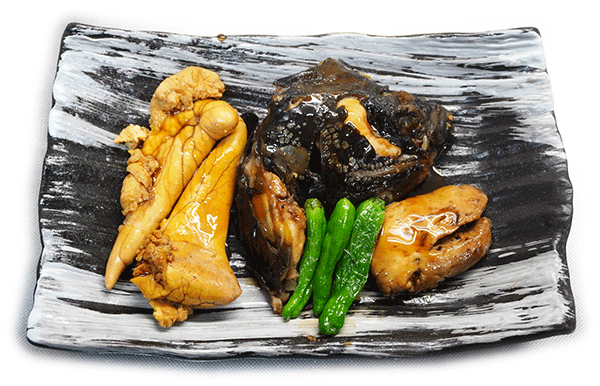
Is this the main character...?
It's not summer, it's winter
At the end of November, I got some fresh stone flounder from Hokkaido. At my usual store, I bought about 1 kg of fish from the person in charge for 1,000 yen each. The fish's body was round and thick with bulges, giving it the typical appearance of a fish that is in season and has stored a lot of fat.
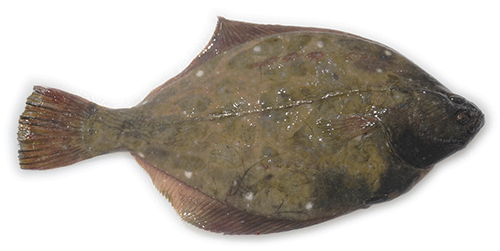
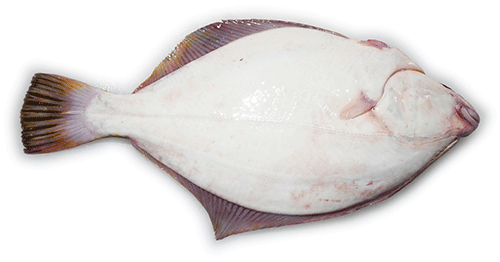
According to some information, summer is considered to be the best season for stone flounder in Tokyo and other areas. When I see a stone flounder that looks like this in front of me during this period from late fall to early winter, I cannot understand why the season for this fish is summer.
Characteristics of stone flounder and how to use them
The stone flounder does not have scales, but has rock-hard bump-like protuberances called stony bony plates in the areas highlighted in the image below. This characteristic is said to have given it the name stone flounder.
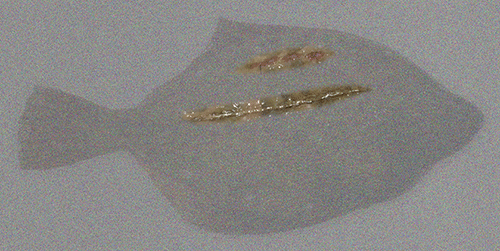
I couldn't find an answer to why this stone-like hard part exists even after searching through fish encyclopedias and the internet. The following is just my speculation without any scientific basis. Since the stone flounder has no scales at all, I imagined that the scales were concentrated and solidified to become hard like stone, like the zeigo of horse mackerel.
In the case of horse mackerel, the scales are concentrated in an area called zeigo, which acts like an armor to protect against predatory fish that bite from behind. That's why I imagined that the stone flounder, which lives on the ocean floor, uses its stone-hard parts to act as armor to protect itself from predatory fish that attack from above.
The basic method of cooking is to separate and discard this stone-like part. These are just stuck to the skin, so you can easily scrape them off with a knife. Below, I will explain the process of internal organ disposal, including stone removal, with images.
| Stone flounder internal organs treatment work process | |
|---|---|
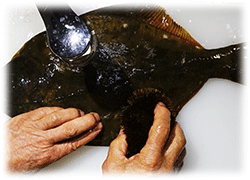 |
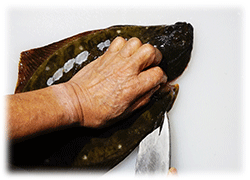 |
| 1,Wash the slime off the top surface of the fish with a scrubbing brush. | 5,Make an incision in the abdomen midway between the top surface and bottom surface sides. |
.gif) |
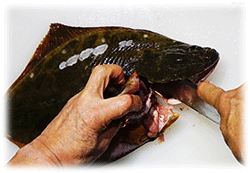 |
| 2,Carefully wash off slime from the bottom surface of the fish. | 6,Separate the other side of the gill base. |
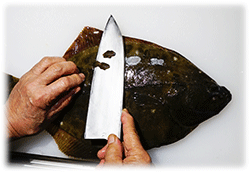 |
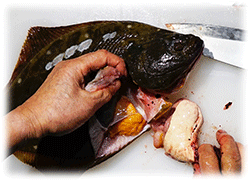 |
| 3,Scrape off the stone on the skin. Since there are no scales, it can be done from both the head and tail sides. | 7,When removing the gills and internal organs, use both hands carefully to avoid damaging the large liver. |
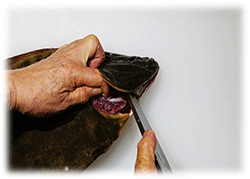 |
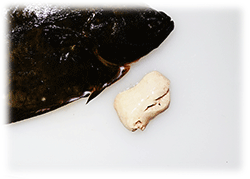 |
| 4,In order to use the head as a product, part of the base of the gills is cut off. | 8,A large liver removed from the abdomen. |
The heads of flatfish members are often discarded as non-edible parts. Assuming that the head is to be discarded, it would be more efficient to leave the gills on the head without removing them, and then separate the body and head with a knife. However, in this case, it was a seasonal stone flounder that was plump and plump, and the cheek meat and a collar of fish meat were also meaty and looked delicious. So I decided to boil the head as well, and removed the gills from the head that were not needed for cooking.
When I opened the abdomen of the stone flounder, I found the liver, which had enlarged completely, had a firm shape, and was clearly fresh. I was also able to see large fish roe, so I thought with a smile that I was lucky.
The next thing I thought about was how to remove the large fish roe that was partially visible without damaging it. I decided to proceed with the knife process carefully, as shown below, to avoid pulling the roe out with my fingers, tearing it off, and ruining its original shape.
| Abdominal separation and roe extraction work process | |
|---|---|
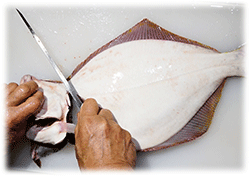 |
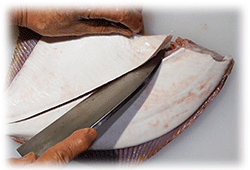 |
| 1,Cut off the head. | 5,Make a vertical cut along the backbone on the bottom surface side, then cut above the centralbone toward the anal fin side. |
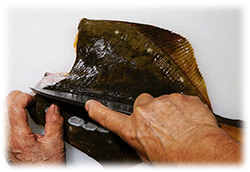 |
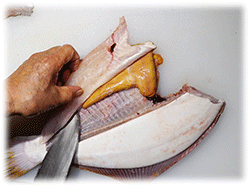 |
| 2,Make a vertical incision along the backbone to near the caudal fin. | 6,Carefully remove the roe by cutting all the way to the fins to avoid damaging the roe. |
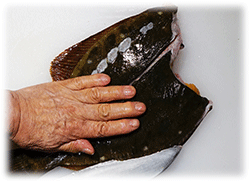 |
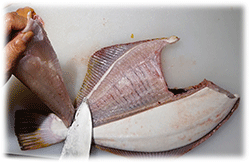 |
| 3,From the cut in the abdomen, cut just above the centralbone toward the backbone. | 7,Separate the bottom surface side of the abdomen. |
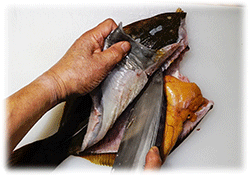 |
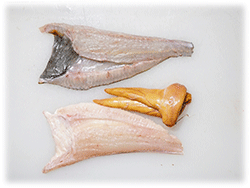 |
| 4,Carefully cut open the large fish roe down to the backbone, taking care not to damage it, and separate the abdomen on the top surface side. | 8,The abdomen on both sides of the top surface and bottom surface, and the removed fish eggs. |
The stone flounder disassembling process up to this point is neither three pieces disassembling nor five pieces disassembling. This is probably a cooking process that many of our readers have never seen before. I did this because I wanted to cook the belly body and back body of a stone flounder in different ways.
Sushi and sashimi using only belly body
For the belly body, I decided to use sashimi and sushi for both the top and bottom of the body, and proceeded with the following work.
| Belly body skinning work process | |
|---|---|
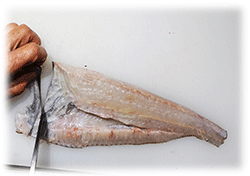 |
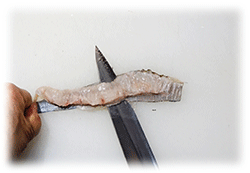 |
| 1,Remove the small bones and thin skin of the abdomen on the top surface side with a knife. | 6,Skinning the engawa on the abdomen on the top surface side. |
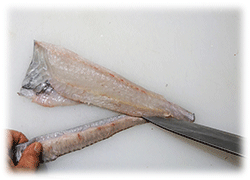 |
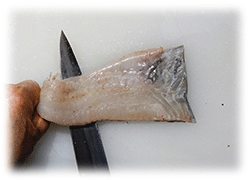 |
| 2,Use a knife to separate the engawa on the abdomen on the top surface side into a wide shape. | 7,Skinning the abdomen on the top surface side. |
 |
 |
| 3,Use a knife to separate the engawa on the abdomen on the bottom surface side into a wide shape. | 8、Skinning the engawa on the abdomen on the bottom surface side. |
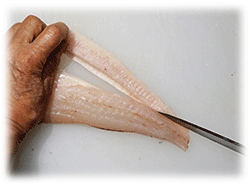 |
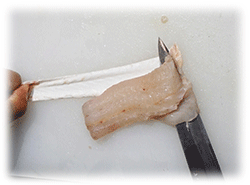 |
| 4,Use a knife to separate the engawa on the abdomen on the bottom surface side into a wide shape. | 9,Skinning the abdomen on the bottom surface side. |
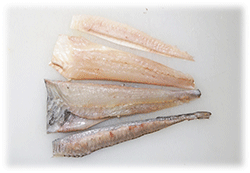 |
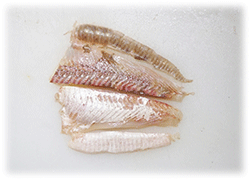 |
| 5,The abdominal engawa is separated. | 10,The abdominal skin is separated. |
Next is nigiri sushi using engawa. There are supposed to be four pieces of engawa in one fish, but in this case there were only two pieces because it was just a belly body, and I was only able to get four pieces of sushi. For this reason, it is not possible to make only Engawa's nigiri sushi, and as a part of the belly body is used, unfortunately it cannot be described as valuable Engawa's nigiri sushi.
The engawa was also plump and thick, and although it was made into a thin and wide shape with double-folding, it was still more than enough to be hard to chew.
| Stone flounder nigiri sushi work process | |
|---|---|
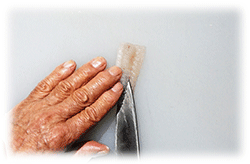 |
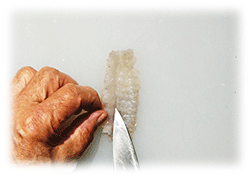 |
| 1,Cut into the engawa on the bottom surface side from the underside of the skin. | 5,Insert the tip of the knife to the very edge of the skin and cut it open. |
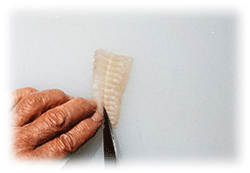 |
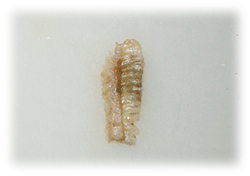 |
| 2,Insert the tip of the knife to the very edge of the skin and cut it open. | 6,The engawa on the top surface side is made into a double-doored state. |
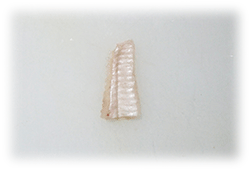 |
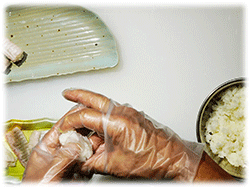 |
| 3,The engawa on the bottom surface side is made into a double-doored state. | 7,Part of the process of making engawa into nigiri sushi. |
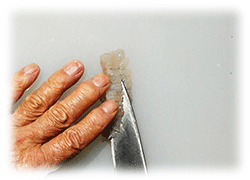 |
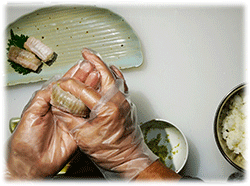 |
| 4,上面側エンガワに皮の裏から切り込む。 | 8,Part of the process of making engawa into nigiri sushi. |
 |
|
| stone flounder nigiri sushi (with engawa) | |
Next is usutsukuri sashimi, which uses only the belly body. In order to take advantage of the cut angle of the skin, all products were commercialized using the sogitsukuri technique.
| Stone flounder usutsukuri sashimi work process | |
|---|---|
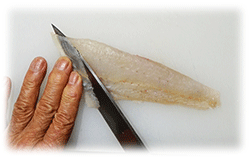 |
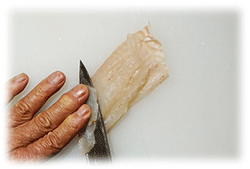 |
| 1,Make a thin cut with the tip of the blade on the belly body on the top surface side while in the left position. | 5,Cut one piece at a time towards the head side. |
 |
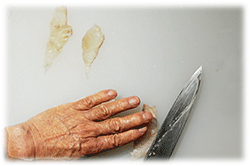 |
| 2,Leaving one piece of skin on, hold the knife upright and pull it toward you to separate it. | 6,Collect parts that are too large, too small, or distorted and use them as materials for hanatsukuri sashimi. |
 |
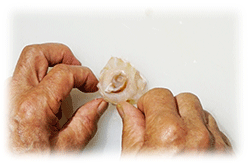 |
| 3,Using your left index finger and thumb, fold the head of the cut sashimi slightly and place it on the plate. | 7,Arrange the ingredients for hanatsukuri sashimi in a row and roll it up from the end to make it look like a rose. |
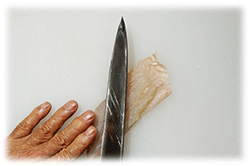 |
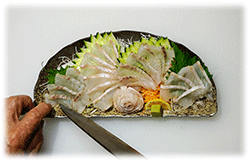 |
| 4,For sogitsukuri sashimi, start cutting from the tail side of the body on the bottom surface side. | 8,Yanagiba knife move the tip of the knife like a finger to fine-tune the final finish. |
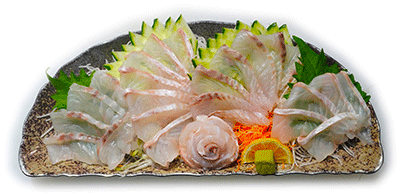 |
|
| Stone flounder usutsukuri sashimi | |
Commercialization of back body
I separated the abdominal part of the stone flounder from the fish body using a slightly different method than the usual method, so the rest looked like the image below. Stone flounder is rather bony, and when you eat it, you will feel the presence of bones. If possible, I decided to also remove the backbone from the fillet in order to soften the presence of the bone as much as possible.
I don't know how readers will perceive the method below, but I hope they can take it lightly and realize that there are other ways of thinking and doing things like this.
| Stone flounder back body fillet | |
|---|---|
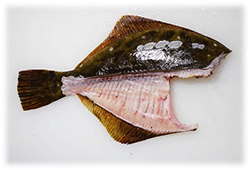 |
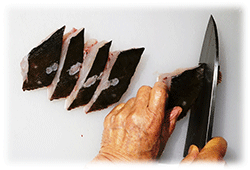 |
| 1,The remaining part of the stone flounder after removing the belly body. | 5,Trim the ends of the fifth and final fillet and shape. |
 |
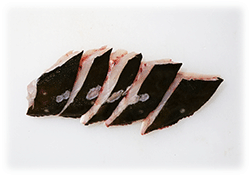 |
| 2,Remove the dorsal fin. | 6,5 fillets cut to almost the same size. |
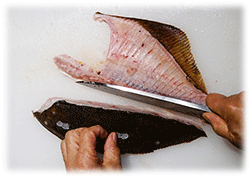 |
 |
| 3,Separate the back body and large bone parts. | 7,Stone flounder fillet (2 pieces) |
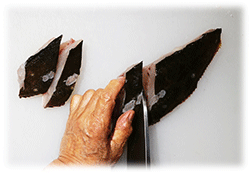 |
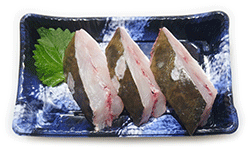 |
| 4,Make fillets by making incisions with the tip of the Deba knife. | 8,Stone flounder fillet (3 pieces) |
This fillet was used to create a dish of "fried fish boiled'' as shown below.
| A dish of "fried fish boiled" using stone flounder Work process | |
|---|---|
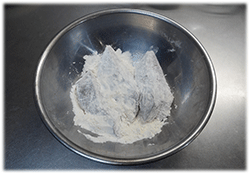 |
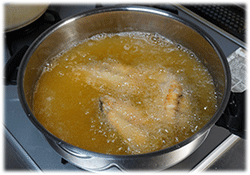 |
| 1,Sprinkle fried chicken powder, which is half flour and half potato starch, all over. | 4,Fry in oil at 170℃ until golden brown. |
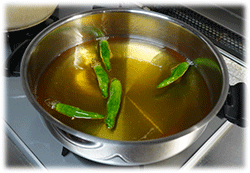 |
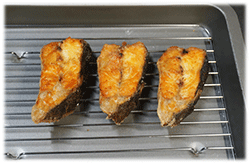 |
| 2,To prevent the shishito peppers from exploding, make a slit with a knife and fry them gently for just a few seconds. | 5,Stone flounder fillet after frying. |
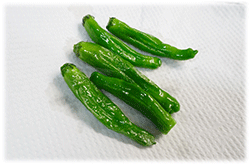 |
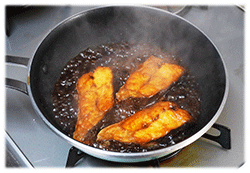 |
| 3,Shishito peppers that still retain their bright green color. | 6,Boil in the broth until it takes on color. |
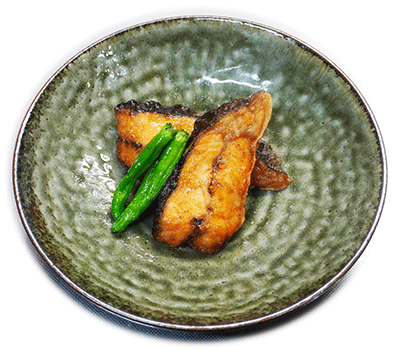 |
|
| A dish of "fried fish boiled" using stone flounder | |
This "fried fish boiled" stone flounder only has a back body and no belly body. There is no fish roe, which is the most delicious and attractive feature of dishes from the flounder family, but this is intentional. It may seem strange to say this, but since there is only half of the central bone, there is no doubt that the bone will be less noticeable when you eat it. I felt that if the stone flounder was over 1kg in size, the back body alone would be large enough to fillet it.
The real pleasure of stone flounder
Now, you may be wondering why there is no fish roe in the boiled flounder, and you might think that it doesn't look like a flounder dish, but this month's issue takes a surprising turn. As you probably already know from the image at the beginning of the book, the fish roe, which is the most attractive feature of the flounder family, is not mixed with the fillets. I added the liver, which is another attractive feature, and added the head as well, creating the product shown below.
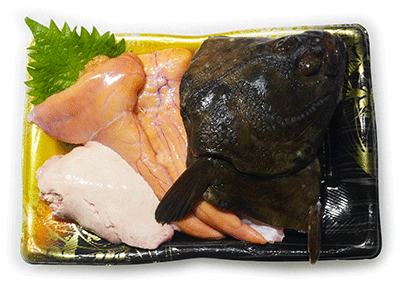
What do you think? Will this product be acceptable as a commercial product? I think that not only people who like fish dishes, but also people who are good at discerning the ingredients of a dish, will suddenly be inspired to create new dishes and salivate when they see this.
I ate it boiled and my reaction was, "This is it! This is the best..." The cooking process is nothing special and is simple as follows.
| Cooking process of stone flounder boiled in ara-ni |
|---|
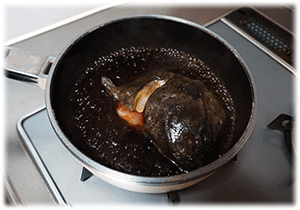 |
| 1,Place the head into the boiling broth. |
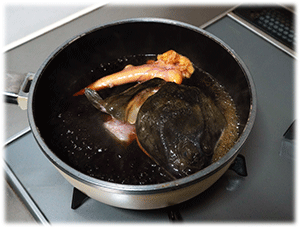 |
| 2,Add the fish roe while occasionally swirling the broth over the head. |
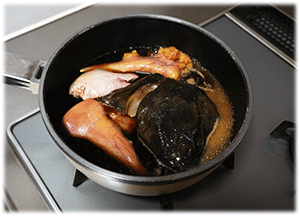 |
| 3,Finally, add the liver and simmer for about 10 minutes. |
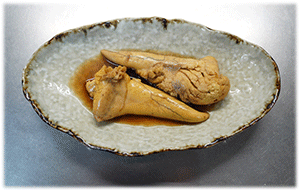 |
4,Remove the fish roe from the pot after about 5 minutes, being careful not to overcook it, and place it on a separate plate, pouring the broth over it so that the flavor is absorbed. |
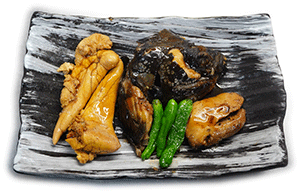 |
| Stone flounder boiled in ara-ni |
Many people who like boiled fish, not just stone flounder but other flounder species, probably prefer to purchase flounder that has roe, and look forward to eating the roe once the dish is ready. I don't think so. Generally speaking, fish roe is considered to be the most appealing aspect of flounder dishes.
Fillets of flounder with roe are not only domestically produced, but also many frozen ones imported from foreign countries, and I feel that we are now living in an era where foreign-produced flounder is more prominent than domestically produced. If you want to eat boiled flatfish with roe, many people may think that these foreign frozen fish are sufficient.
However, like the stone flounder, have you ever seen foreign frozen flounder with fresh roe on sale, which has extremely fresh liver in its belly?I have never seen one.
Not only do fish livers vary in size depending on the size of the fish and the season, but because they are not protected by egg membranes like fish eggs, they tend to lose their shape, lose freshness quickly, and discolor easily. In other words, fish liver has various difficulties when handling it. Even monkfish liver, the most famous fish liver, is rarely sold in its original form, and monkfish liver products called ankimo are sold in plastic bags. If a fish's liver retains its original shape while retaining a color that indicates freshness, that is its value, and it can be considered that the larger the size, the higher the value.
If it is a liver like the stone flounder that I dealt with this time, its value is definitely high. In addition, if you combine it with large, plump, well-colored, and fresh-looking fish roe, you should consider it to be of very high quality as a dish.
I would like to emphasize once again that I placed stone flounder usutsukuri sashimi, nigiri sushi, and back body boiled fish at the same time and ate them all and compared them. As a result, the ara-ni was so delicious that I exclaimed, ``This is the best...''
If you're wondering if cooking stone flounder ara-ni is difficult, it's not at all, and you can say that it's not that easy. In other words, the high quality of fish roe and liver as cooking ingredients was reflected in the results.
What kind of customer base does the store you belong to have as customers? If there are a certain number of customers who recognize stone flounder's products as valuable, I believe that the author's suggestions in this month's issue will be effective. I don't think there are many customers who would understand a product proposal in which the main and supporting roles are reversed, but the important thing is how many customers who understand this kind of thing can be attracted. I believe that whether or not your store can survive in the future will depend on whether or not you can do that.
| Please access the following URL if you want to secure using SSL. All pages in the site will be secure pages. |
https://secure02.blue.shared-server.net/www.fish-food.co.jp/message english 12.2023.html |
An opinion and the communication are to iinfo@fish food times
Date of updating 1 Dec. 2023
